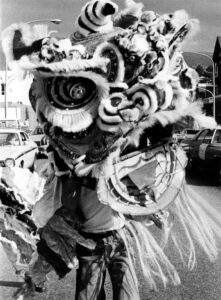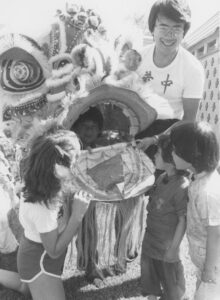

With May being Asian Heritage Month, it is a perfect time to uncover one of the Vernon Museum’s most fascinating, but rarely seen, artifacts.
In 1985, a traditional Chinese lion head was donated to the museum by the Chinese Free Masons. Due to its fragile condition and rarity, the head is rarely put on display, but spends most of its time in a custom-made storage container.
It is made from a framework of bamboo and wire, with brightly-coloured paper fleshing out its shape. Levers and pull-strings on its underside allow the eyes and mouth to be manipulated, and a long swath of fabric forms its body.

Although its exact age is unknown, the head is believed to be more than 120 years old, and was the first to be used in Vernon. This incredible artifact made appearances at many important city events, including festivities hosted in honour of B.C.’s 100th Anniversary in 1958.
The head was also used at local Chinese New Year celebrations. While the traditional dragon dance requires at least nine performances, lion dances only require two, with one managing the head and one the body. Vernon’s lion costume was usually operated by two members of the local Chinese community, Walter Joe (1916-2005) and John Wong (1921-2001).
Lion dancing is believed to have originated in either the Han (206 BC-220 AD) or Tang Dynasty (618-907 AD), and has continued to evolve as form of cultural expression ever since.
To explore more of Vernon’s history, check out our other blog posts!
Gwyneth Evans, Research and Communications Coordinator

